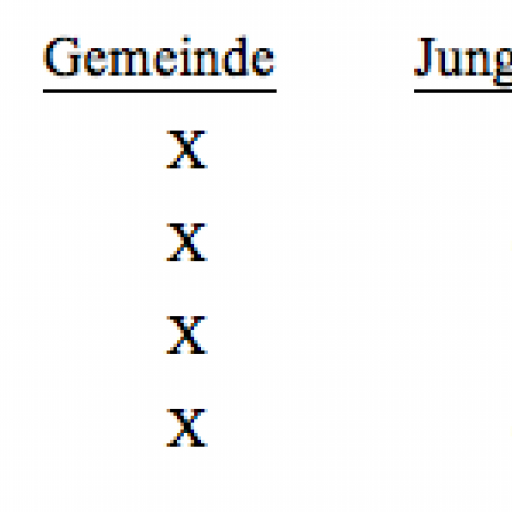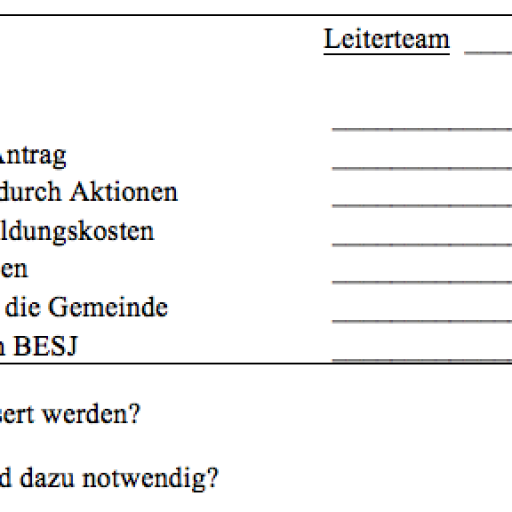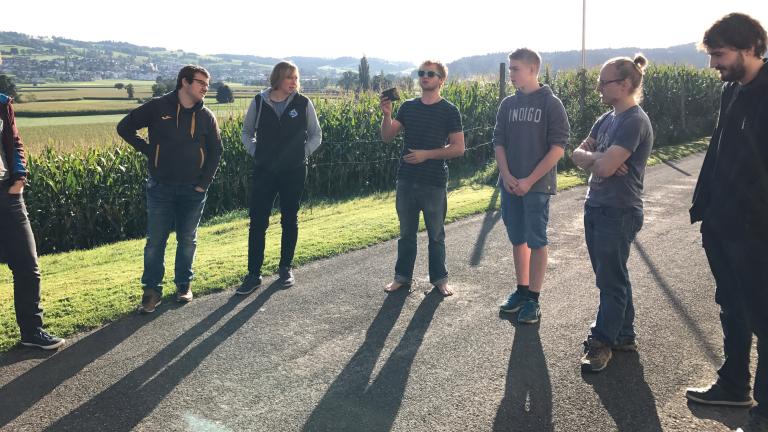Nobody will deny that Ameisli, youth group and teen work costs something. But who should pay for it? The youth leaders? The church? Sponsors? Or simply donors?
Some suggestions for the general Jungschar budget
- Regular, monthly contributions from the community
- Annual fixed contribution from the municipality
- Contribution is processed via the municipal budget
- Contributions at the request of the Jungschar
- Offerings from special events in the community with the participation of the Jungschar
- Combinations of proposals such as
- Fixed contribution and sacrifice and activities of the Jungschar
- Fixed contribution and additional contributions as proposed by the Jungschar
It makes little sense if the necessary material is generally paid for by the leaders. If there are differences in the team, this can have serious consequences for the Jungschar work. The right way is for the Jungschar to have its own fund. This is fed by the church. However, the leaders make their gifts available to the congregation. The leaders are reimbursed for their expenses by the Jungschar fund, whereby practice shows that not all expenses are charged to the leaders. However, it makes sense for unreimbursed expenses to be recorded as donations and expenses. Such handling shows the true picture of the costs and donations for a Jungschar.
The Jungschar keeps a cash book and submits this to the church treasurer for inspection for the annual accounts. The treasurer can integrate the annual figures into the overall accounts. This means that the financial matters are clearly regulated and can be viewed at any time.
It makes perfect sense for the whole youth group to contribute to the financing. This makes the youth group members and their parents aware that the youth group also costs something. It is unique in the Swiss association landscape that no annual fees are charged to participants/members for extracurricular youth work activities. Only a few youth clubs do this, similar to scouts.
What can the financial budget of a youth club look like, or rather its income?
- A fixed monthly contribution from the municipality of e.g. CHF 3 per child, in accordance with the budget for the overall youth work of the municipality.
- Self-generated funds of the Jungschar through, for example, candle drawing, car washing events, play festivals, Christmas events, offerings from events organized by the Jungschar in the community, etc.
- Grants from the municipality for special purchases or events, subject to prior consultation.
Please note: In many municipalities, the contribution or funds for additional larger purchases must usually be claimed via the budget entry. Subsequent applications are rather difficult and entail a corresponding administrative effort.
The material purchased is the property of the municipality and no leader can take anything with them when they leave, unless they have made certain materials available on loan.
Financing the training and further education of youth leaders
The training and further education of leaders for good Jungschar work must be a concern of the church. It is important to encourage the leaders to do so. Partial reimbursement of training costs by the congregation strengthens the positive attitude and loyalty of the leaders to the congregation. It is also a form of recognition and appreciation of their commitment by the congregation. It is not a matter of course that young people are willing to invest part of their vacation time for youth camps, Pentecost camps, possibly youth weekends and one week and one or two weekends per year for training. We believe that this should be estimated with a contribution. However, we support the fact that this does not have to be the full amount for educational reasons. The BESJ considers a payment of 50% of the course costs to be sensible, whereby different weightings can be applied between pupils/students and earners. The fact that a large proportion of leaders do not have religious parents and have to cover the costs of the courses themselves, even if they do not yet have an income, also speaks in favor of such a regulation. As a result, it happens time and again that participants in training weeks save up for the course costs from their pocket money over months and for more than a year.
The insurance contribution
Young people's groups from Chrischona parishes are required to join the young people's group insurance. For all other youth groups, membership is voluntary. However, as around 2/3 of all youth groups are insured, a few thoughts are warranted at this point. Who should, must or may pay the annual contribution? The municipality, the youth group from its own funds, or the parents? A uniform regulation will hardly be possible, as the financing options are too different. If a youth group is generously supported and has the possibility of special financial campaigns, the contribution can certainly be paid from the youth group's treasury. Otherwise, this is the responsibility of the municipality. Another option is to pass on the insurance contribution to the parents, which is usually possible without any problems if the appropriate information is provided. This can also be done on a voluntary basis. Parents receive a friendly letter each year with the option of paying this contribution voluntarily. A payment slip is enclosed. Practical experience has shown that more than the required amount is often collected in this way. Here, too, it is important to seek an open discussion. The issue can be raised very well at a parents' evening, for example.
The municipal contribution to the BESJ
This is levied differently depending on the denomination. This contribution is a partial compensation for the general services of the BESJ, whose beneficiaries are primarily the municipalities. We are of the opinion that these costs should be borne in full by the municipality and not by the youth fund or even by the leaders personally, as is sometimes the case.
So who finances the costs of the Ameisli, Jungschar and teen work?
A sensible investment in the Jungschar work and in the training of the leaders is a good, future-oriented investment.
Practical steps
How is the financing of the Jungschar organized? The church leadership and the Jungschar team independently fill out the following evaluation table. The results are then compared and discussed. An open discussion is important (point scale from 1 - 6; 1 = very bad, 6 = very good).
References:
Contents: Annual focus 1993 "Community", Peter Blaser, Siegfried Nüesch, Martin Bihr, Hansruedi Tanner, Ueli Obrist, Johannes Wallmeroth, Peter Schulthess
Copyright: www.besj.ch
Cover picture: Clipart courtesy of the publishing house buch+musik ejw-service gmbh, Stuttgart - www.ejw-buch.de
Content may be automatically translated. Help improve the quality of the translation with your editing!






